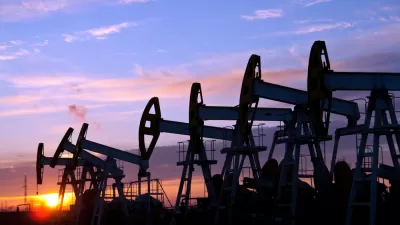While holding out promise for oil industry advocates, shale oil extraction in the United States appears to obey the law of diminishing returns.
"Oil production technology is giving us ever more expensive oil with ever diminishing returns for the ever increasing effort that needs to be invested," writes Raymond Pierrehumbert, basing his assessment on American Geophysical Union (AGU) data on the untapped shale oil reserves of the United States.
According to the AGU, there are under 3 trillion barrels of shale oil in the U.S. with a 1-2% recoverability rate. Oil trapped in shale formations requires breaking up the substrate or heating it to high temperatures.
While oil industry advocates predict endless oil abundance, geophysical data suggests the opposite scenario. Roughly 1/3 of U.S. shale oil reserves would meet consumption needs for only two years based on 2011 rates. Drilling frequency has increased five times since the year 2000, but the returns have remained static.
The U.S. is also unlikely to surpass Saudi oil production, which exceeds U.S. production by 3.5 million barrels a day.
While high oil prices can spur improved drilling technologies, they also can deplete the resource more rapidly. Because of market and environmental concerns - extracting all the oil from U.S. shale reserves would increase global temperatures by 2 degrees Celcius - the AGU predicts that these deposits will remain inaccessible.
Pierrehumbert holds out hope for improved and efficient extraction in the future and cautions against developing unconventional oil reserves like Alberta's tar sands now, while recognizing that fossil fuel dependence is not a long-term plan.
FULL STORY: The Myth of “Saudi America”

Planetizen Federal Action Tracker
A weekly monitor of how Trump’s orders and actions are impacting planners and planning in America.

Map: Where Senate Republicans Want to Sell Your Public Lands
For public land advocates, the Senate Republicans’ proposal to sell millions of acres of public land in the West is “the biggest fight of their careers.”

Restaurant Patios Were a Pandemic Win — Why Were They so Hard to Keep?
Social distancing requirements and changes in travel patterns prompted cities to pilot new uses for street and sidewalk space. Then it got complicated.

DC Area County Eliminates Bus Fares
Montgomery County joins a growing trend of making transit free.

Platform Pilsner: Vancouver Transit Agency Releases... a Beer?
TransLink will receive a portion of every sale of the four-pack.

Toronto Weighs Cheaper Transit, Parking Hikes for Major Events
Special event rates would take effect during large festivals, sports games and concerts to ‘discourage driving, manage congestion and free up space for transit.”
Urban Design for Planners 1: Software Tools
This six-course series explores essential urban design concepts using open source software and equips planners with the tools they need to participate fully in the urban design process.
Planning for Universal Design
Learn the tools for implementing Universal Design in planning regulations.
Heyer Gruel & Associates PA
JM Goldson LLC
Custer County Colorado
City of Camden Redevelopment Agency
City of Astoria
Transportation Research & Education Center (TREC) at Portland State University
Camden Redevelopment Agency
City of Claremont
Municipality of Princeton (NJ)



























